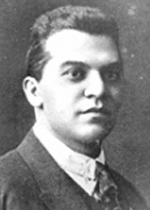Reti Richard (26.05.1889 – 06.06.1929)
 Czechoslovakian Grandmaster level, chess theorist, and composer of endgame studies, chess literature. Reti studied mathematics and physics in Vienna where he received extensive practice in chess and began to play chess professionally before World War I. He wrote chess columns for Becsi Magyar Ujsag, Morgen Zeitung in Ostrava, Algemeen Handelsblad in Amsterdam, Berliner Borsen-Courier, Berliner Bilden-Courier, partly earning his living.
Czechoslovakian Grandmaster level, chess theorist, and composer of endgame studies, chess literature. Reti studied mathematics and physics in Vienna where he received extensive practice in chess and began to play chess professionally before World War I. He wrote chess columns for Becsi Magyar Ujsag, Morgen Zeitung in Ostrava, Algemeen Handelsblad in Amsterdam, Berliner Borsen-Courier, Berliner Bilden-Courier, partly earning his living.
Reti started to play chess and showed his best results in the international tournaments in Vienna, where he was the first in 1909, the second in 1912, and the third in 1913. In 1918 he was the winner in Kaschau, ahead of Milan Vidmar and Carl Schlechter, in 1920 at Goteborg, ahead of Akiba Rubinstein and Efim Bogoljubow, Vienna, and Amsterdam, shared the first-second place in 1922 in Teplice-Sanov with Rudolf Spielmann ahead of Ernst Gruenfeld and Akiba Rubinstein; in 1923, in Ostrava, he came in second after Emanuel Lasker, followed by Ernst Gruenfeld, Efim Bogoljubow, and Akiba Rubinstein; in 1927, performed second at Bad Homburg behind Efim Bogoljubow; in 1928, he was the first in Vienna, Giessen, and Stockholm; the same year he was the second at Dortmund and equal first at Brno with Friedrich Saemisch. From 1918 until his death, he played in 25 important tournaments with good results. He was the winner of the Czech Championship in 1925 and was the captain of the Czech National Team in the first World Chess Olympiad in 1927, where he made the highest first board score – 11,5 points out of a possible 15. Reti played nine matches, three of them he won: from Julius Breyer with a score 5,5- 1,5, Adolf Olland 6-4 and Max Euwe 3-1, and drew one with Sevielly Tartakower with a score 3-3.
He performed simultaneously blindfolded in San Paolo in 1925, where he established his own record playing on 29 boards scoring +20-2=7. He was one of the outstanding representatives of the hypermodern movement in chess and as Alekhine said, he was the only Grandmaster who was often struck by his unexpected ideas.
Reit was famous for his book: Die Neuen Idien im Schachspiel (1922), dealing with the history of chess strategy and translated into English in 1923 as Modern Ideas in Chess. His last work Die Meister des Schachbretts was published after his death and contained biographical notes and annotations explaining the strategy of 23 masters’ games. The English translation Masters of the Chess Board appeared in 1932 in New York. Reti’s book The New Ideas in Chess was the first book of the new romantic school.
In his ideas and principles, nothing is more meaningful for Reti than his victory, which was considered by him as a triumph of his ideas rather than his personal one. Therefore, it is understandable that he is a promising challenger for Lasker. As the justification of the new school principles was questioned by Lasker, Reti considered it as his duty for the sake of his ideas to cross the barrier: he forgot that not only idea struggles against the idea, but also a man versus man, as everywhere, not “gut” thing does not always win. Finally, Reti attained worldwide fame as a study composer, less so because of the number of his studies, but most probably, however, because of their quality, which made him famous as a true artist at the chessboard.
Reti’s sudden death at the age at only 40 years of age was the consequence of scarlet fever.



